Mind-Blowing Facts About Your Child’s Growing Brain & Body!
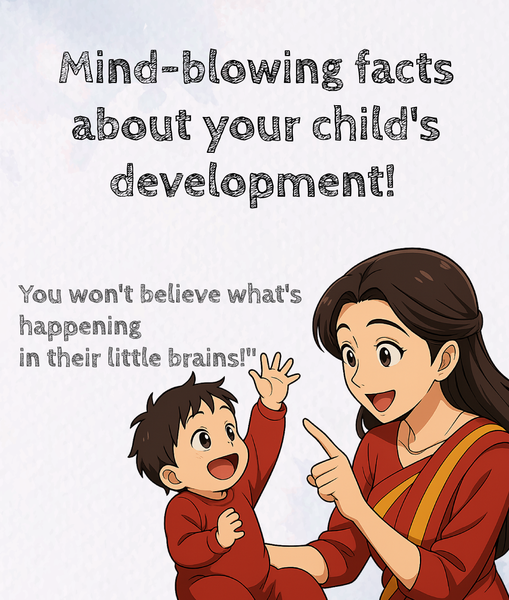
Discover 10 fascinating facts about your child’s development—brain growth, language bursts, emotional bonds & more. Science every parent should know!
The Astonishing Science of a Developing Child: 10 Things You Never Knew
Watching your child grow is one of life's greatest joys. In just a few short years, they go from a tiny newborn to a curious, chatty toddler. While we can easily see them getting bigger and stronger, there's an even more incredible journey happening inside their bodies and brains. Every little moment—a shared smile, a warm hug, a silly song—is actually a building block for their future. The science of child development shows us that these simple interactions are powered by amazing biological events.
In this guide, we'll pull back the curtain on the astonishing science of how your child develops. We'll explore not just what happens, but the fascinating how and why behind it all. You'll discover how the simple, everyday things you do help build a healthy, happy, and confident person. We’ll dive into the incredible growth of your baby's brain, the clever design of their bones, the powerful science behind a cuddle, how their senses develop, the amazing 'language explosion,' and even what's happening when they dream.
Did You Know a Baby's Brain Forges Up to 1,000 New Neural Connections Every Second?
The human brain is the most complex thing in the universe, and its most important construction happens in the first few years of life. This isn't just simple growth; it's a brilliant process of building a massive network and then carefully shaping it based on your child's experiences.
The Brain's Big Bang: A Super-Connected Start
A baby is born with 100 to 200 billion brain cells (neurons), but they aren't fully connected yet. Right after birth, their brain starts building connections, a process called
synaptogenesis, at an incredible rate. In these early years, your child's brain forms between 700 and 1,000 new neural connections
every single second.
This explosion of connections is called transient exuberance. By age two, their brain is denser with these connections than it will ever be again, even in adulthood. Why? This overproduction creates a brain that is incredibly flexible and ready to adapt to whatever world it finds itself in. It’s the secret behind how babies learn so much, so fast.
The Art of Brain Sculpting: Use It or Lose It
After this "big bang" of connection-building, the brain starts a crucial clean-up phase called synaptic pruning. Think of it as a sculptor chipping away extra stone to reveal a masterpiece. The brain gets more efficient by getting rid of what it doesn't need.
The rule is simple: "use it or lose it." Connections that are used regularly get stronger, while those that are rarely used are cleared away. This isn't a bad thing—it's essential for helping the brain work faster and master more complex skills. About 40% of the connections made in the early years are eventually pruned away, a process that continues through childhood and into adolescence.
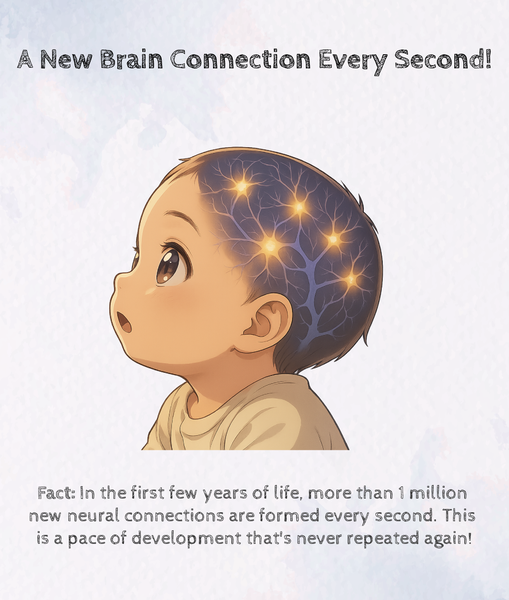
The "Serve and Return" Principle: Your Role as Brain Architect
So, what decides which connections stay and which ones go? Your child's experiences. The everyday interactions you have with your child are literally building their brain. One of the most important ingredients is the "serve and return" interaction.
It's like a game of tennis. Your child "serves" by babbling, pointing, or making a face. You "return the serve" by responding with a smile, a word, or a hug. Each of these simple back-and-forth exchanges strengthens neural connections. When you name an object they point to, you're building language pathways. When you smile back, you're wiring their brain for social and emotional health. These loving interactions provide the blueprint for a strong brain foundation. For more ideas, explore these
fun, brain-boosting activities.
On the flip side, toxic stress—like from chronic neglect or abuse—can weaken the brain's architecture if a child doesn't have a supportive adult to buffer them. This is why a stable, loving environment is so critical for
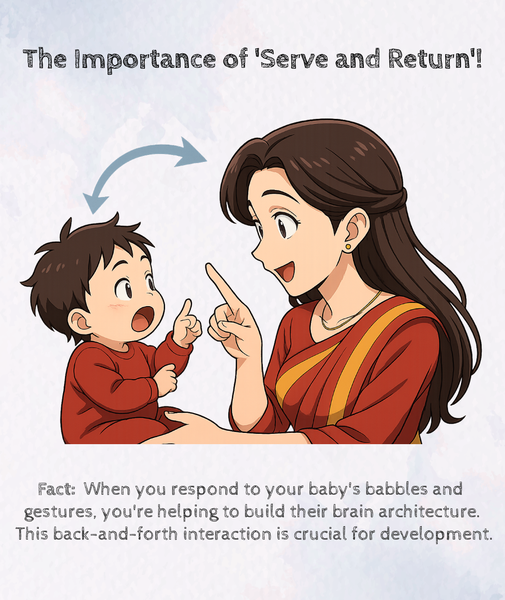
Did You Know a Baby's "Soft Spots" Are a Feat of Evolutionary Engineering?
An infant's skeleton is another marvel of development. It's not just a smaller version of an adult's; it's a dynamic system with temporary features designed for the incredible journey of birth and early growth.
The Living Skeleton: From Cartilage to Bone
The process of bone formation, called ossification, starts early in pregnancy and continues into young adulthood. The skeleton begins as a flexible blueprint made of cartilage and membrane, which is then gradually replaced by hard bone in two main ways.
- Intramembranous Ossification: This is a direct process where a sheet of connective tissue turns into bone. It's how the flat bones of the face and most of the skull are formed. This is what keeps a baby's skull bones from being fused at birth.
- Endochondral Ossification: This is a longer process where a cartilage model is replaced by bone. It's how the long bones in the arms and legs are formed, and it allows for growth throughout childhood at the "growth plates."
The Cranial Gateway: The Purpose of Fontanelles
The famous "soft spots" on a baby's head are called fontanelles. They are flexible, membrane-covered gaps where the skull bones haven't yet joined. A newborn has six, but the two you can easily feel are the anterior (on top) and posterior (at the back) fontanelles. These spots are brilliant for two reasons.
First, they allow the skull bones to shift and overlap during birth, a process called molding. This helps the baby's head pass safely through the birth canal without harming the brain.
Second, they allow the skull to expand to make room for the brain's incredibly fast growth. A baby's head does two-thirds of its growing by age two! Without these gaps, brain growth would be restricted.
The fontanelles can also give you clues about your baby's health. It's always a good idea for parents to know some first-aid fundamentals. Here's what to look for:
- Anterior Fontanelle (the larger, diamond-shaped spot on top):
- Typical Closure: Usually closes between 7 and 19 months of age.
- Sunken Appearance: Can be a sign of dehydration. Look for other signs like fewer wet diapers or being less alert.
- Bulging Appearance: When your baby is calm and upright, a persistent bulge can be a sign of increased pressure in the brain from a serious condition like meningitis or hydrocephalus and needs immediate medical attention.
- Posterior Fontanelle (the smaller, triangle-shaped spot at the back):
- Typical Closure: Closes much earlier, usually by 1 to 2 months old.
- Sunken Appearance: Can also be a sign of dehydration.
- Bulging Appearance: Like the anterior fontanelle, a persistent bulge when your baby is calm can indicate increased pressure and requires a doctor's visit.
A quick note: It's normal for fontanelles to bulge a little when your baby is crying, lying down, or vomiting. They should go back to being soft and flat when your baby is calm and sitting up. If you're ever concerned, trust your instincts and call your doctor.
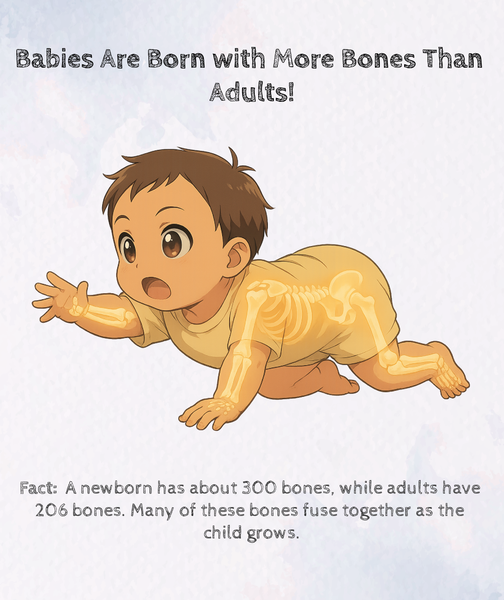
Did You Know a Hug Is a Potent Neurochemical Cocktail for Your Baby's Brain?
For an infant, touch is their first language. A hug or a cuddle is so much more than just a sweet gesture—it's a powerful biological signal that releases a flood of helpful chemicals in the brain, building the very foundation of emotional security and trust.
The Chemistry of a Cuddle: Oxytocin vs. Cortisol
When you give your baby a warm, affectionate hug, their brain releases oxytocin, often called the "love hormone." This amazing chemical fosters feelings of trust, connection, and social bonding—the bedrock of all relationships.
At the same time, oxytocin works to lower the body's levels of cortisol, the main stress hormone. When your child is upset or having a tantrum, their cortisol levels are high. A hug can chemically calm their system down, helping them feel safe and secure. This loving touch also releases endorphins (natural painkillers) and other feel-good chemicals like serotonin and dopamine.
From Touch to Trust: Building Secure Attachment
This simple act, repeated over time, is what forges secure attachment—the deep psychological bond that gives your child a lifelong sense of safety. Consistent, loving touch teaches their developing nervous system that the world is a safe place.
The long-term benefits are incredible. Children with secure attachment are more likely to become adults with :
- Higher Self-Esteem: They feel good about themselves and confident in their abilities.
- Better Emotional Regulation: They can handle stress and bounce back from setbacks more easily.
- Healthier Relationships: They are better at giving and receiving love and navigating conflicts.
- Improved Social Skills: They tend to be more empathetic and attuned to others.
These are some of the best parenting hacks for building strong bonds. On the other hand, a lack of touch can have serious negative effects, even stunting physical growth and weakening the immune system.

The Maternal Echo: A Hardwired Response to a Baby's Cry
This is a two-way street—a caregiver's brain is just as involved. A mother's response to her baby's cry isn't just a choice; it's a deeply ingrained, automatic reaction.
Brain scans show that within a second of hearing her baby cry, a mother's brain lights up in areas linked to empathy and caregiving. This response is supercharged by oxytocin, which makes mothers more sensitive to their baby's needs. This is called
maternal attunement, and it's key to building that secure bond. Research even shows that breastfeeding mothers, who often have higher oxytocin levels, have an even stronger brain response when they hear their baby cry.
This creates a powerful feedback loop: the baby cries, the mother's brain is wired to respond, she gives a hug, the baby calms down, and the mother's brain feels rewarded. This beautiful cycle is the physical process that builds the foundation for a lifetime of emotional health and helps in
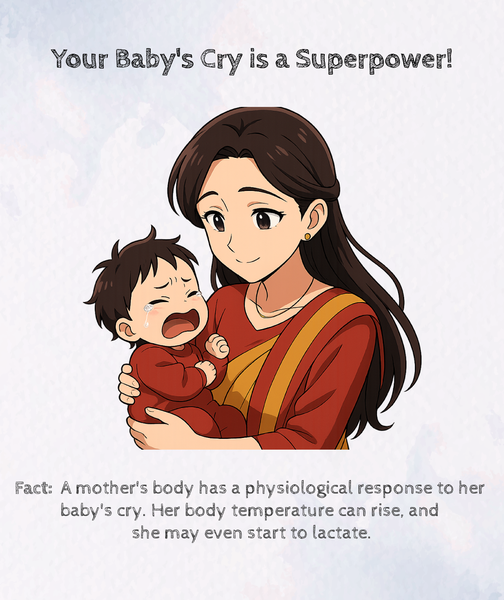
Did You Know Your Newborn Can't Taste Salt?
A baby's experience of the world is different from ours in so many ways, including their sense of taste! While taste starts developing before birth, their palate isn't fully online when they arrive. The way their taste buds mature is perfectly designed for their first food, but our modern diet can sometimes get in the way.
The Awakening Palate: A Gradual Development
A baby's taste buds start forming around the eighth week of pregnancy. At birth, they can already tell the difference between certain flavors. They have a strong, built-in love for sweet tastes (which is why they love breast milk!) and a dislike for bitter and sour things.
But here's a fun fact: newborns can't taste salt. The specific taste receptors for saltiness just aren't mature yet. This ability doesn't kick in until they are around
3 to 4 months old.
Once those salt detectors are working, an interesting thing happens. Around 4 months, babies who didn't care about salt before will suddenly prefer salty water over plain water. This seems to be a natural, biological shift. It's another example of brilliant evolutionary design. Breast milk is naturally low in salt but has all the sodium a baby needs, so there's no need for them to prefer salt at birth. The preference develops right around the time they might have started trying other foods.
A Taste for Life: Why You Shouldn't Add Salt
While a baby's initial preference for salt might be biological, their preference for salty foods is a learned response. Giving babies salty foods early on can set them up for a lifelong craving for a high-salt diet. This is a big deal, because too much salt is linked to serious health problems later in life. For great ideas on healthy eating, check out these
delicious and nutritious recipes for kids.
The main risks of too much salt include:
- High Blood Pressure and Heart Disease: Too much salt is a leading cause of high blood pressure, which increases the risk of heart disease and stroke.
- Obesity: Salty foods make you thirsty, which can lead to drinking more sugary, high-calorie drinks. High salt intake might also be an independent risk factor for obesity.
- Other Health Risks: Too much sodium can cause the body to lose calcium, which could affect bone health down the road.
Because of these risks, health experts all agree: do not add salt to the food you prepare for your baby. By honoring your baby's natural development and avoiding added salt, you're helping to establish
healthy eating habits from a young age and setting them up for a lifetime of good health.
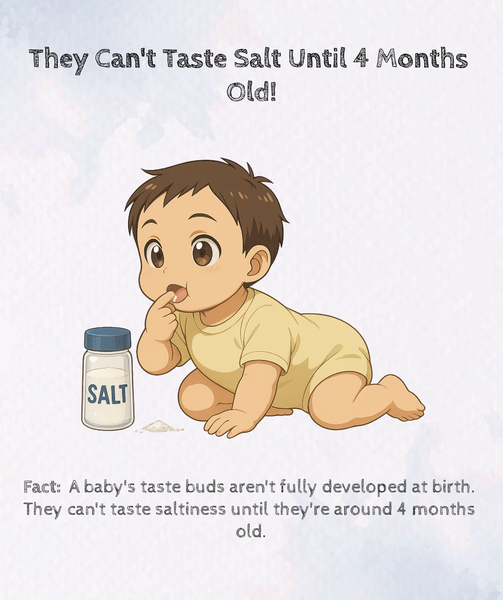
Did You Know Your Toddler's Gibberish Is a Prelude to a "Language Explosion"?
Sometime between 18 and 24 months, many parents get to witness one of the most thrilling milestones: the "language explosion." Suddenly, a toddler who only knew a few words starts picking up new ones at a mind-boggling speed. This isn't magic; it's the result of some serious detective work happening inside their brain.
The Vocabulary Volcano: A Burst of Words
The "language explosion" is a period of super-fast word learning. Your toddler might go from learning a couple of new words a week to learning as many as
ten new words every day.
By 18 months, a toddler might have 10-50 words, but by 24 months, that can jump to 200-300 words! This is also when they start putting two words together to make their first little sentences, like "more juice" or "blue car."
A key skill behind this is "fast mapping." This is a toddler's amazing ability to figure out a new word's meaning after hearing it just once or twice. For example, if they know "apple" and "cup," and you ask them to get the "banana" from a group of all three, they can use the process of elimination to learn the new word. It shows their brain is actively solving the puzzle of language.
Fueling the Fire: How to Support Their Language Journey
While learning language is natural, the environment you create can turn a spark into a bonfire. The best way to help isn't with flashcards, but with fun, interactive conversations. For more tips, explore how to create steps to early education success.
- Comment and Expand, Don't Just Question: It's tempting to quiz your toddler ("What's that?"), but this can feel like a test. A better approach is to comment on what they say and expand on it. If they say, "Car," you can say, "Yes, that's a big red car! It's going so fast!" This models richer language in a natural way.
- Use Rich Language: Talk to your toddler in complete sentences. Narrate your day, talking about what you're doing and seeing. This stream of words is the raw material they need to learn.
- Embrace Repetition: Toddlers love repetition for a reason—it's how they learn! Reading the same book for the twentieth time helps them master the sounds, rhythms, and meanings of words.
The Symphony of Reading and Singing: Building Literacy
Reading, speaking, and singing are all powerful, connected tools for building the skills they'll need to learn to read later on.
Singing songs and nursery rhymes is especially helpful. The music slows down language, helping their brains pick out the individual sounds in words—a skill that's critical for reading. The rhythm and patterns also make new words easier to remember.
Reading books together exposes them to new words and more complex sentences than they might hear in daily conversation. Just talking about the pictures in a book is a great way to teach them that things have names. And here's a bonus: some research suggests that listening to complex classical music can prime the brain for spatial reasoning, and learning an instrument can improve a child's ability to solve puzzles by as much as 30 percent!
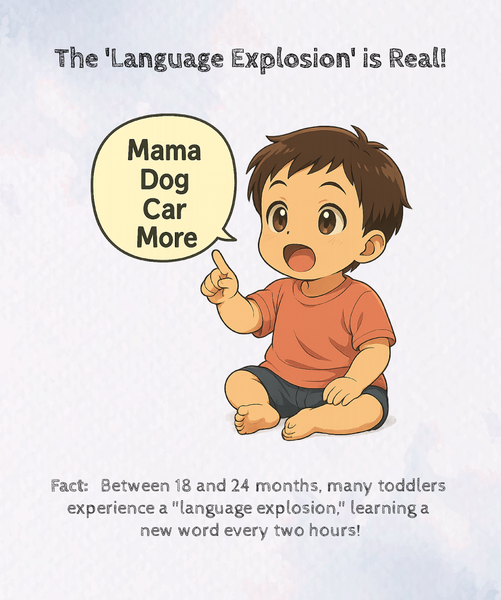
Did You Know a Newborn Spends Most of Their Sleep Time Dreaming?
For a newborn, sleep isn't just rest—it's one of the most important and active jobs they have. While we adults sleep to recover, a baby sleeps to build their brain from the ground up.
The Primacy of REM Sleep
Newborns sleep a lot, often 16 to 18 hours a day. What's amazing is how much of that time is spent in
REM (Rapid Eye Movement) sleep, the stage where we do our most vivid dreaming. A newborn can spend
40 to 70 percent of their sleep in REM, which is up to 11 hours a day! For premature babies, it's even more—up to 80 percent.
This is a huge contrast to adults, who only spend about 15 to 20 percent of their sleep in REM. This difference shows just how critical REM sleep is for a developing baby. You can find more information on
the importance of sleep for children's health and development in our detailed guide.
The Function of a Dream: Brain Building, Not Storytelling
So, what do babies dream about? While we can't know for sure, scientists don't think they're dreaming of complex stories like we do. Instead, it's believed that infant REM sleep has a much more fundamental job: building the brain.
Here's what's likely happening during their dream time:
- Processing the Day: Scientists think baby dreams are the brain's way of replaying and making sense of all the new sights, sounds, and feelings they experienced while awake. This is crucial for learning and locking in memories.
- Wiring the Brain: Most importantly, REM sleep is when the brain's construction of new neural connections goes into overdrive. The intense brain activity during this stage is literally building the brain's architecture and wiring the central nervous system. The famous psychologist Jean Piaget said play was the "work" of children, but for a newborn, the real work happens during sleep.
- Emotional Development: There's also evidence that REM sleep helps develop coping skills and emotional regulation, laying the groundwork for their future emotional health.
In short, the high-energy state of REM sleep gives the brain the internal workout it needs to grow and mature. For a baby, sleeping is one of the most productive things they can do. For more tips, check out our ultimate guide to baby sleep.

The Lifelong Echo of Our First Thousand Days
The journey from conception through the first few years is the most important period of human development. As science shows us, it's a time of incredible and rapid construction, where the foundations of a person are built. The brain's explosive growth, with a thousand new connections forming every second, is carefully shaped by the "serve and return" of your loving interactions. The skeleton is a marvel of engineering, with soft spots designed to make birth possible and allow the brain to grow.
We see that our emotions are tied to our biology. The simple act of a hug releases a chemical cocktail that builds trust and security, setting the stage for a lifetime of emotional resilience. The development of taste and the explosion of language are active adventures, profoundly shaped by the world you create for your child. And even in sleep, the infant brain is hard at work, using dreams to build its own amazing structure.
The research is clear: the foundation for lifelong learning, behavior, and health is set in these critical early years. This doesn't mean you have to be a perfect parent, but it does show the incredible power you have. Every song you sing, every story you tell, every cuddle you give, and every smile you return is a meaningful act of building a human being. Remember to cherish life's little moments, because they have the biggest impact of all.

Comments
No comments yet. Be the first to leave a comment!